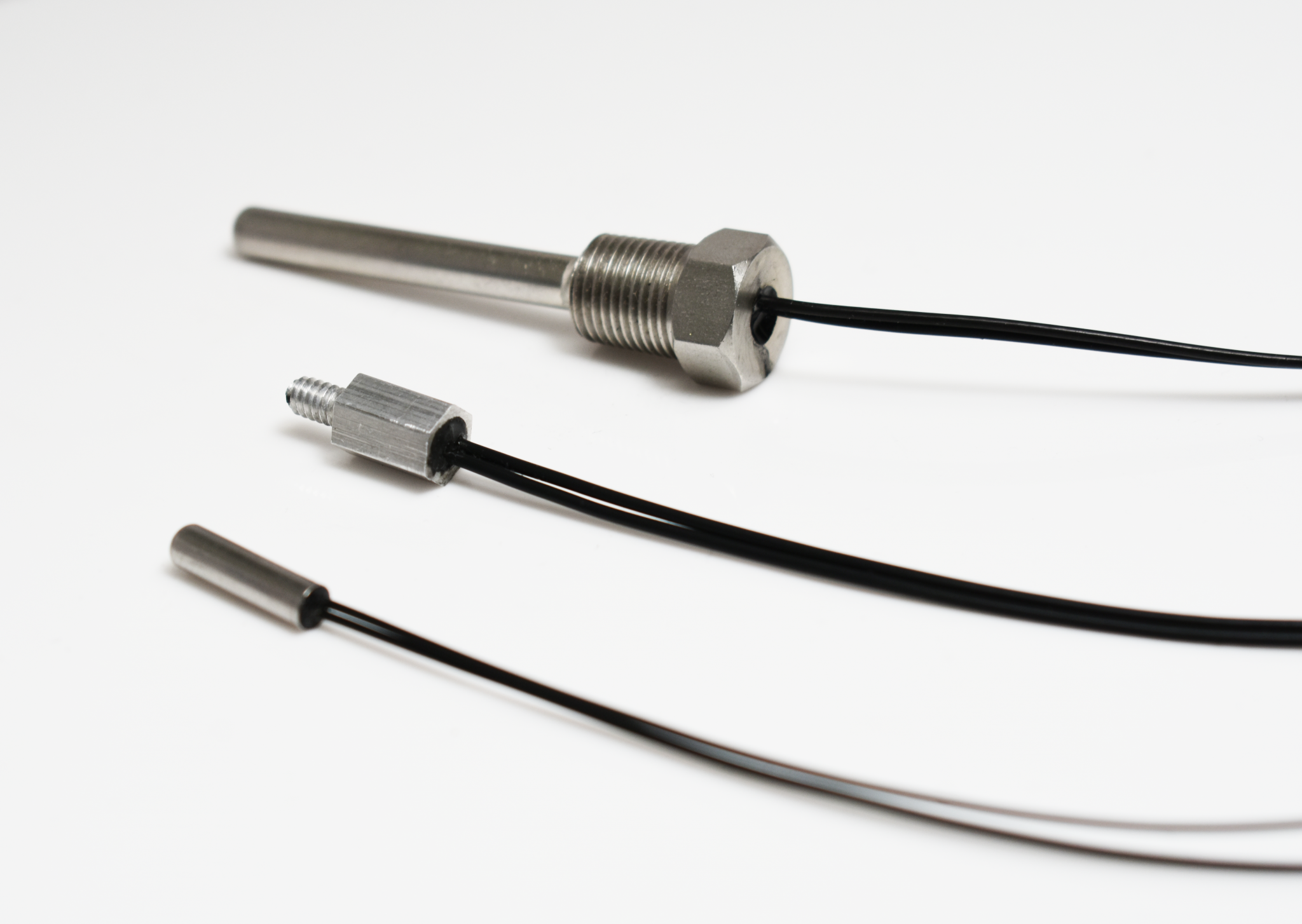NTC Thermistor Probes Have Endless Applications
NTC thermistor probes measure liquid levels and temperature in industries that extend from automotive electronics to medical technology to green energy. Their applications are endless, and their purpose ensures the operability of the applications they serve.
A thermistor probe, can also be as simple as an NTC thermistor chip, encapsulated with epoxy or glass. Or, it can be potted in a metal or plastic housing with two high-temperature insulated wire leads.
These NTC thermistors are in all the places that we live and work, from the moment we wake up and make coffee until the end of the day when we arrive home and relax in front of the television. They are indispensable to the cars we drive to work, the computers necessary to do our jobs, and the appliances we use to prepare food at the end of the day.
Understanding temperature sensing probes and their applications
It is essential to understand how NTC thermistor probes operate, in what capacity, and what their potential is. Part of this understanding includes the electrical properties of probes that abide by certain operating principles, including electrical resistance, responsiveness, and pressure and thermal conductivity.
Given their pervasiveness and range of applications, and despite many thermistor sizes and shapes, it is impossible to manufacture a universal NTC thermistor probe assembly. Temperature sensors used in automobiles are different from the temperature sensors used in wind turbines.
Thermistor probes in automotive innovation

Without thermistor temperature sensing probes, many automobiles, appliances, industrial equipment, and anything that requires feedback control would not function properly, or at all. Engineers depend on these NTC thermistor sensors as a design consideration for any product that generates energy, hot or cold, and requires temperature measurement, compensation, and control.
In 1966, automotive vehicles used around two thermistors per unit. This number grew to 60 thermistors per unit in the 90s, and today there are between 80 to 100 NTC thermistors in one vehicle. The exponential increase in temperature sensing devices parallels the complexity and refinement of technology. As automotive technology has increased and improved, so has the demand for temperature sensors. Car seat heaters, air conditioners, window defrosters, and oil temperature gauges require detection, regulation, and temperature control. Now, as electric vehicles become more common, NTC thermistors are used more than ever. Li-ion batteries in cars have become much more economical in the last 7-10 years. Thermistors are vital for maintaining an ideal battery temperature during the charge and discharge cycle.
Improving technology allows for more features and processes requiring accurate and reliable temperature sensing. For example, thermostats previously measured coolant temperature and controlled the cabin climate; today, thermistors have replaced thermostats as thermistors are faster, more accurate, and more reliable. NTC sensors can also detect oil levels and viscosity, alerting the driver when it needs to be changed.
Medical Technology
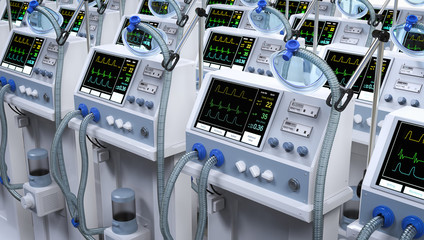
Today, especially during Covid-19, thermistor probes have a crucial role in medical technology. Ventilators are machines that help patients breathe. In a healthy person, the inside of the nose and mouth warms and humidifies the air we breathe to body temperature, roughly 37°C. When a patient is in respiratory failure, like seen with the coronavirus, a ventilator does the breathing for them. A temperature sensor must be accurate, sensitive, and responsive for such a task. A discrete temperature sensor analyzes the air temperature and sends signals to the respirator, ensuring the airflow is appropriate.
Thermistors also have a role in cardiac output assessments. A thermistor probe makes up the tip of a Swan-Ganz catheter. After injecting a cold solution into the bloodstream, doctors use the thermistor to detect blood temperature changes. Doctors can calculate the amount of blood pumped by the heart within a specific time frame. Again, the temperature sensing device must be incredibly accurate to detect the minuscule changes in temperature.
Green energy

Green energy is an area where the use of thermistor probes is making great strides. In 2007, a team in Japan used an NTC Thermistor to create a better braking system for small wind turbines. The traditional breaking circuit damages the turbine’s rotors and the generator’s windings through a short-circuit current. Using an NTC thermistor in the breaking circuit was safer and more cost-effective. NTC probes are also able to measure the temperature of the blades in cold environments. When a wind turbine’s blades freeze, the turbine becomes inefficient and is subject to inoperability. NTC probes relay temperature information to the wind turbine’s heater, allowing the turbine to compensate for the cold temperature and prevent freezing blades.
NTC thermistors can also measure water temperature to analyze increasing global temperatures. Through accurate, reliable, and stable data detection, environmental scientists can determine how quickly oceans and lakes are warming up. The NTC thermistor is another excellent option for this application because they retain their accuracy over long periods, thus reducing the potential for data collection interruptions and skewed results.
Everyday applications
NTC thermistors are in almost every appliance, from freezers to portable heaters. In a preventative capacity, thermistors reduce the chance of instruments, like microwaves or portable heaters, from overheating and starting a fire. Other appliances include computers, air conditioners, and fire alarms.
How to select and integrate thermistor probes into different applications
Similar to the limitless applications requiring NTC thermistor probe assemblies, so too exist the endless methods to mount them, adhere them, and apply them. Housing and mounting for some probe assemblies can be simple to very sophisticated.
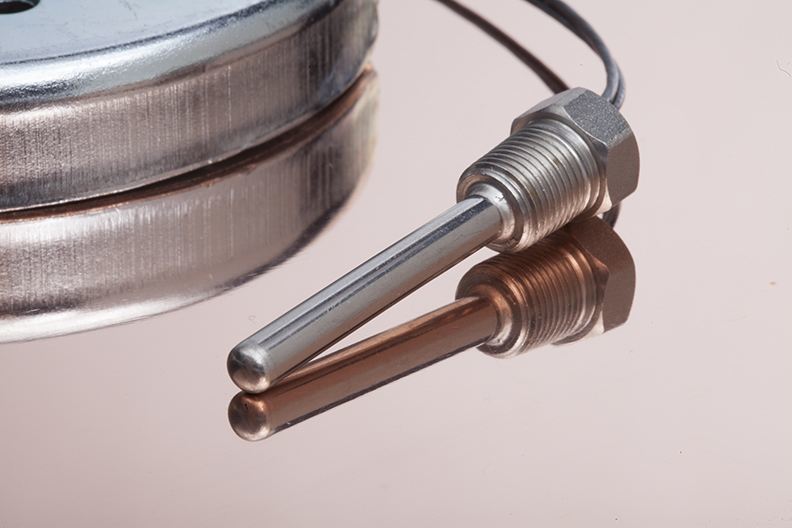
When talking about a probe, the metal or plastic assembly housing covers the bead thermistor for different applications and functions. These probes come in all shapes, sizes, and mounting options. Some NTC thermistor probes are long and narrow with a stainless steel housing used in vehicles for measuring oil or water temperature. Other temperature sensing probes integrate a threaded tube used in engines or medical equipment to detect and monitor the temperature. Probes with a ring lug design are often used together with heatsinks or lithium-ion batteries.
Each thermistor temperature sensor starts as a tiny chip attached to two thermally insulated wires. Glass or metal housing covers the probe. At the same time, thermally conductive epoxy fills the remaining space inside the housing. Probes are further customized based on precise requirements for their applications. When used with an application such as a lithium-ion battery, an NTC probe with a ring lug can be easily mounted securely to the battery terminal. This probe assembly effectively monitors the battery temperature, so it does not rise above operational or safety temperatures.
In the chart below, we illustrate different thermistors and the housing with which they are compatible.
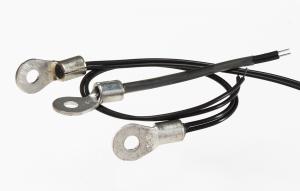 | 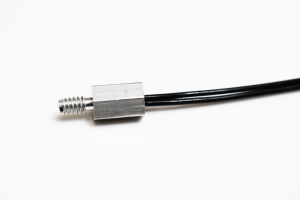 | 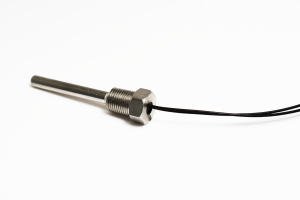 | 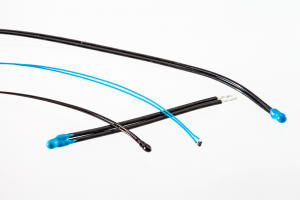 | 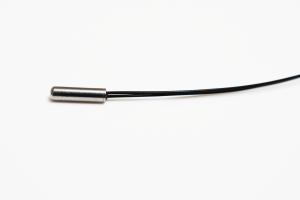 | 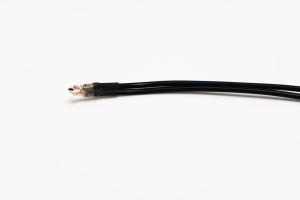 |
|
|---|---|---|---|---|---|---|
| Probe | PANR | PANT | PANW | PANE | PANH | PANG |
| Thermal Time Constant (S) | 40 | 40 | 25 | 10 | 10 | 3 |
| Dissipation Constant (mW/°C) | 3 | 3 | 10 | 3 | 3 | 3 |
| Max Power (mW) | 125 | 125 | 125 | 125 | 125 | 125 |
| Type of Housing | Tinned Metal Ring Lug | Stainless Steel 304 Threaded Tip & Hex | Aluminum Threaded Metal Tubing & Hex | Probe Assembly with Epoxy | Stainless Steel 304 Closed End Metal Tubing | Glass Bead |
| Description of Probe | Epoxy dip coated NTC thermistor potted in tinned copper ring lug | NTC thermistor potted inside aluminum hex screw with straight threads | NTC thermistor potted at the tip of durable stainless steel allow tube with tapered thread hex screw | Epoxy dip coated NTC thermistor soldered between jacketed Teflon/PVC wires | NTC thermistor inside durable stainless steel alloy tube and epoxy filled | Glass encapsulated bead thermistor with Teflon coated wires |

